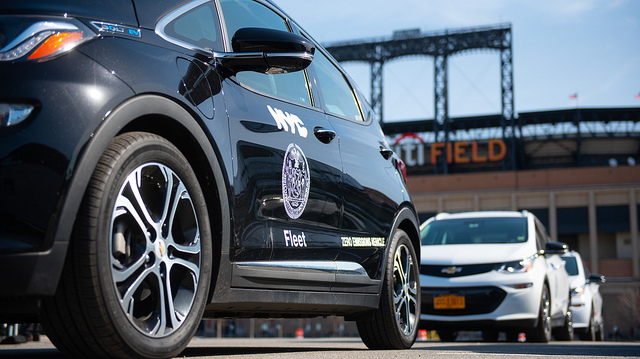Mayor De Blasio is Ahead of Goal of Cutting City Fleet By a Tiny Amount
It’s a small victory, thanks to small goals.
The city is ahead of schedule in scaling back the number of gas-guzzling, carbon-spewing government vehicles on the road — with the de Blasio administration removing 586 vehicles from the bloated city fleet, a figure that is more than halfway to City Hall’s pledge to remove 1,000 vehicles by June, 2021.
To be clear, the pledge, made in March, 2019, is small-bore: there were 25,690 vehicles in the city fleet when the self-proclaimed fossil fuel fighter de Blasio made the promise to trim that number by 1,000 (or just 4 percent). The current fleet of 25,104 is finally below the 25,585 vehicles that the city owned when de Blasio took office in 2014. He promptly expanded the fleet by 19 percent before he started tackling the issue in 2018, as Streetsblog reported.
So, to start, let us first praise small things moving in the right direction:
“The Department of Citywide Administrative Services is delivering ahead of schedule on the mayor’s commitment to have a smaller and more sustainable city fleet,” agency spokesman Nick Benson told Streetsblog. “There are fewer city vehicles on our streets, fewer employees using vehicles to commute, and fewer gallons of fossil fuels being burned each day.”
More good news: Those 586 fewer cars cut the city’s fuel use by 302,310 gallons and reduced the fleet’s carbon emissions by about 2,687 metric tons.
But, again, those advances are undercut by the modesty of the goals: The 302,310-gallon reduction in fuel use since March, 2019, averages out to about 25,000 gallons per month — or roughly 1 percent of the city’s average monthly fuel use, which was roughly 2.4 million gallons per month in the first four months of the current fiscal year.
Emissions follow a similar pattern: Those 2,687 metric tons of reduced emissions since March, 2019, amount to roughly 224 metric tons per month. But the city’s overall fleet spews about 21,574 metric tons of carbon into the air every month — so the reduction again amounts to about 1 percent.
In addition to the 2.3-percent cut in fleet size since March, 2019, the city has cut the number of municipal workers who commute to and from their jobs via government cars, eliminating 397 “take-home” vehicles out of the pledge to remove cars from 500 workers by June, 2021.
Again, that’s a drop in the bucket: roughly 3,050 city workers, including members of the NYPD, have “take-home” vehicles. So even when de Blasio completes his pledge, more than 2,500 city workers will retain this particular perk.
However you look at it, the mayor’s pledge is exceptionally modest. Indeed, between July, 2018, and June, 2019, city vehicles logged 187.3 million miles — which was 4.5 million more miles than the previous July-to-June period, an increase of 2.5 percent.
But at least the city is moving in the right direction. But the pace of change is grinding.
“While it’s nice that the city is making progress on its pledge to cut the fleet by 1,000 vehicles, it will still leave the city with several thousand more vehicles than when the mayor took office, and that’s a big problem,” said StreetsPAC’s Eric McClure. “The mayor is fond of talking about climate change, but with the transportation sector being New York City’s second largest emitter of greenhouse gases, we need more than talk.”






